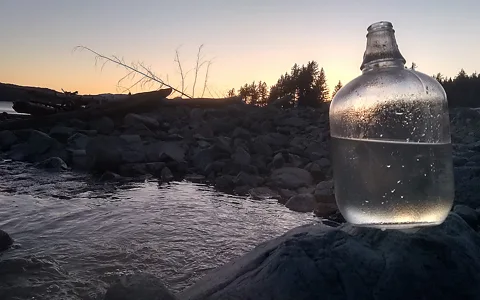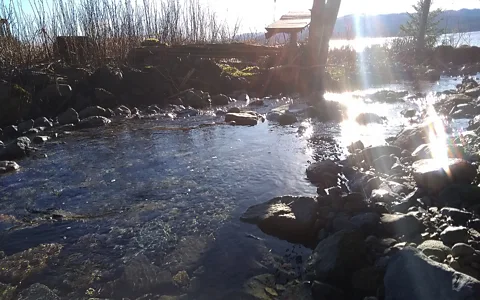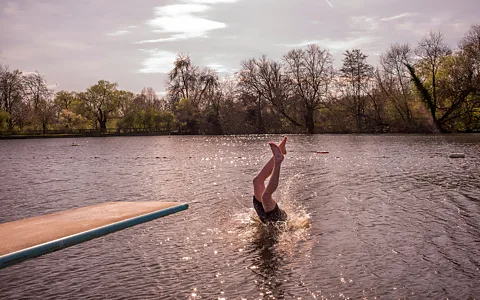Why are people thirsty for 'raw water'?
 @OptimizingMe
@OptimizingMeWhat’s really behind the interest in untreated water? Tim Smedley investigates.
“Anybody here drink water, but wish you could pay more for it?” In January 2018, the “raw water” movement was doing the rounds on the US TV comedy circuit, and it was Stephen Colbert’s turn on The Late Show. “Well, good news,” continued Colbert, “because the next big start-up craze in Silicon Valley is ‘raw water’… water that’s unfiltered, untreated and unsterilised. Wow, drinking that sounds unsane!”
This followed a New York Times article mocking a new craze in San Francisco’s tech heartland for bottles of untreated spring water sold by companies such as Live Water for $36.99. These start-ups extolled the benefits of drinking “real water… within one lunar cycle of delivery”.
You might also like:
However, not everyone was laughing. Some were taking notes. Drinking water is typically highly regulated, and the market for buying and selling untreated water remains small and anecdotal. But the website Findaspring.com shows that “raw water” has since become a global movement of people seeking out their own wild water sources. Eager users list and map thousands of natural wells and springs across the world for people to drink from.
While the site’s disclaimer urges people to test all spring water before drinking it, its explainer video Why Spring Water by site founder Daniel Vitalis makes bold claims such as “we’re biologically adapted to [raw water] as an animal” and “we’re not any more adapted to refined H2O than we are to refined carbohydrates”.
 @OptimizingMe
@OptimizingMeYou don’t have to dig very deep to find the downsides, however. A user comment left directly below Vitalis’ video reads: “Remember, some springs can be contaminated with E-Coli, for example. We used a spring out of Millersburg OH for years and then a barnyard was put in up high on the hill... Three of us got really sick.”
Val Curtis, professor of hygiene and director of the Environmental Health Group at the London School of Hygiene and Tropical Medicine, has grave concerns about the ‘raw water’ movement. “This seems to me a really backward step,” she says. “We’ve gone to such great lengths in society to actually solve the problem of the contamination of drinking water by purifying it and supplying it in good condition. And we’ve even improved it by putting chlorine and fluorine in it to kill all the bugs and improve your teeth… these arguments were won years and years ago.”
Curtis asks, presumably rhetorically: “Do we really want to go back to the Stone Age?” But Live Water’s homepage (which prominently links to Findaspring.com) suggests that is precisely the aim, claiming that humans “have drank unprocessed spring water for 99% of our existence”.
 @OptimizingMe
@OptimizingMeBBC Capital approached both Live Water and Daniel Vitalis for an interview, but they were unavailable for comment. Vitalis however clearly practises what he preaches. His Instagram account (with over 29,000 followers) is full of hunting and foraging pictures, and his online show WildFed champions the “emerging modern subsistence culture” and “foraging right here in our local food-shed”. In his view, natural is therefore always best and returning to our ancestral roots is the desired objective.
While there is some science supporting the “paleo diet”, says Curtis, a line must be drawn at clean water. Our ancestors “also died in vast rates from typhoid, cholera, giardia, diarrhoeal disease,” says Curtis. Life expectancy for our real Palaeolithic ancestors was decidedly low. As for “probiotic” claims that “raw water” contains many of the good bacteria we need for gut health, Curtis argues that while it may do, it may also include all the bad ones too.
Vitalis’ video claim that “tap water is contaminated with antibiotic substances… [and] chlorine and fluoride which we know is neurotoxic” is also rejected by Curtis. Fluoride and chlorine “are not known to do any harm to us in the amount that you have in water,” she says. “There is absolutely no evidence that residues of drugs like antibiotics do any harm to human health, even if they are detectable in tiny parts per million. It’s the same old thing – people don’t seem to get the idea that if something is present in very, very tiny amounts, it’s not dangerous!”
 Alamy
AlamyIn 2018, Galen Zink moved from a tech job in Silicon Valley to pursue self-sufficiency and “nutritional self-optimisation” on a remote island in Southern Alaska. Despite being aware of the concerns raised by Curtis, he drinks almost exclusively from his local stream. “It’s so common here,” says Zink, who believes there are health benefits. “It’s got probiotic bacteria in there… Drinking raw water improves microbiome health.” He’s also observed that “drinking raw water as your primary hydration for a few days yields noticeably smoother skin”.
One thing both Zink and Curtis can agree on, however, is that pristine rural environments with sparse human habitation are the most likely to have safe wild water sources. “I had to come to this insanely remote island to find what really feels like clean air and water,” says Zink of Prince of Wales Island, Alaska. Its population is just 3,000 spread across 2,230 square miles (5,776 km squared), with little in the way of agriculture, let alone industry. “If you’re anywhere near anything civilised, odds are surface water will be contaminated,” admits Zink. “Trying to cut corners and drink from springs you find online is probably not the right choice for most people. It’s all too easy to feel a benefit at first but then slowly poison yourself on herbicides.”
When I click “locate a spring” on Findaspring.com, however, I find 56 located in England, where I’m based. Many of these are in urban areas, including five in London. The only way to test the water quality, says Curtis, is to send “samples of water off for microbiological assays, at some expense… and you would need to sample it in different seasons to be sure”.
Gail Teitzel, editor of the journal Trends in Microbiology, says: “You’d need to test the water every single time for microbial and chemical contaminants. Municipal and bottled water has already been tested and proven safe… It’s like a raw egg – by cooking the egg, or by treating the water, you kill whatever pathogens might have been in it.” When I suggest that many bottled mineral water brands are taken directly from natural springs, she says that “bottled water is regulated so that it doesn’t contain dangerous microbes or chemicals”.
Recent studies have found that 90% of bottled water brands and 83% of tap water samples across 12 countries contain tiny particles of plastic known as microplastics (the US had the highest tap water contamination rate, at 94%). While seeking out “raw water” seems extreme, isn’t this a response to genuine concerns about modern water quality? “I worry that because of that, raw water enthusiasts might be underestimating the danger of untreated water,” says Teitzel. “Microplastic contamination of drinking water definitely needs further study but we know that areas that lack treated drinking water have higher rates of infant mortality, in large part from water-borne diarrheal diseases.”
Ultimately, if people want to drink untreated water, isn’t that their choice in a free society? Here, Curtis draws parallels to the anti-vaccination movement. “One of the reasons why I don’t get sick very often is because you don’t go around drinking dirty water. But if you did and you got sick, you’d be a risk to me or your colleagues.” One example: the drinker gets E. coli, uses a communal bathroom or handles food in the staff cafeteria, and so passes it on. “If you do [drink raw water], you have to take some responsibility that you might be a source of risk to others as well, not just yourself.”
Colbert’s skit on The Late Show wryly concluded that “there could be a downside to drinking out of puddles”. That would seem harsh on people like Zink, who have sought out remote regions and based their choices on local knowledge. Or in Iceland, where 98% of tap water remains chemically untreated glacial water. But Alaska and Iceland are literally the outliers. For urbanites, tap water remains the safer, healthier option.
